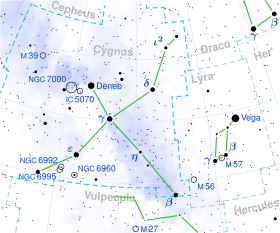
Supergiants are among the most massive and most luminous stars. Supergiant stars occupy the top region of the Hertzsprung–Russell diagram with absolute visual magnitudes between about −3 and −8. The temperature range of supergiant stars spans from about 3,400 K to over 20,000 K.

Zeta Puppis, formally named Naos, is a star in the constellation of Puppis.
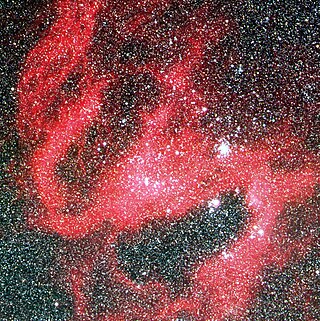
S Doradus is one of the brightest stars in the Large Magellanic Cloud (LMC), a satellite galaxy of the Milky Way, located roughly 160,000 light-years away. The star is a luminous blue variable, and one of the most luminous stars known, having a luminosity varying widely above and below 1,000,000 times the luminosity of the Sun, although it is too far away to be seen with the naked eye.

Luminous blue variables (LBVs) are massive evolved stars that show unpredictable and sometimes dramatic variations in their spectra and brightness. They are also known as S Doradus variables after S Doradus, one of the brightest stars of the Large Magellanic Cloud. They are extraordinarily rare, with just 20 objects listed in the General Catalogue of Variable Stars as SDor, and a number of these are no longer considered LBVs.
Alpha Cygni variables are variable stars which exhibit non-radial pulsations, meaning that some portions of the stellar surface are contracting at the same time other parts expand. They are supergiant stars of spectral types B or A. Variations in brightness on the order of 0.1 magnitudes are associated with the pulsations, which often seem irregular, due to beating of multiple pulsation periods. The pulsations typically have periods of several days to several weeks.
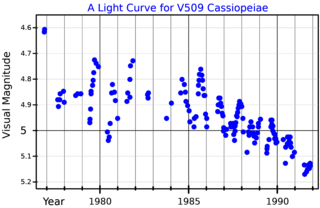
V509 Cassiopeiae is one of two yellow hypergiant stars found in the constellation Cassiopeia, which also contains Rho Cassiopeiae.

Cygnus OB2 #12 is an extremely luminous blue hypergiant with an absolute bolometric magnitude of −10.9, among the most luminous stars known in the galaxy. This makes the star nearly two million times more luminous than the Sun, although estimates were even higher when the star was first discovered. It is now known to be a binary, with the companion approximately a tenth as bright. A very approximate initial estimate of the orbit gives the total system mass as 120 M☉ and the period as 30 years.

HR Carinae is a luminous blue variable star located in the constellation Carina. It is surrounded by a vast nebula of ejected nuclear-processed material because this star has a multiple shell expanding atmosphere. This star is among the most luminous stars in the Milky Way. It has very broad emission wings on the Balmer lines, reminiscent from the broad lines observed in the spectra of O and Wolf–Rayet stars. A distance of 5 kpc and a bolometric magnitude of -9.4 put HR Car among the most luminous stars of the galaxy.

A hypergiant (luminosity class 0 or Ia+) is a very rare type of star that has an extremely high luminosity, mass, size and mass loss because of its extreme stellar winds. The term hypergiant is defined as luminosity class 0 (zero) in the MKK system. However, this is rarely seen in literature or in published spectral classifications, except for specific well-defined groups such as the yellow hypergiants, RSG (red supergiants), or blue B(e) supergiants with emission spectra. More commonly, hypergiants are classed as Ia-0 or Ia+, but red supergiants are rarely assigned these spectral classifications. Astronomers are interested in these stars because they relate to understanding stellar evolution, especially star formation, stability, and their expected demise as supernovae.

Zeta1 Scorpii is a B-type hypergiant star in the constellation of Scorpius. It has an apparent visual magnitude which varies between 4.66 and 4.86. It is a member of the Scorpius OB1 association, and the open star cluster NGC 6231, also known as the "Northern jewel box" cluster. Around 36 times as massive as the Sun, it is also one of the most luminous stars known in the Galaxy, with an estimated bolometric luminosity of around 850,000 times that of the Sun and a radius 103 times that of the Sun.

HD 168607 is a blue hypergiant and luminous blue variable (LBV) star located in the constellation of Sagittarius, easy to see with amateur telescopes. It forms a pair with HD 168625, also a blue hypergiant and possible luminous blue variable, that can be seen at the south-east of M17, the Omega Nebula.

55 Cygni is a blue supergiant star in the constellation Cygnus. It is thought to be a member of the Cygnus OB7 stellar association at about 2,700 light years.

WR 148 is a spectroscopic binary in the constellation Cygnus. The primary star is a Wolf–Rayet star and one of the most luminous stars known. The secondary has been suspected of being a stellar-mass black hole but may be a class O main sequence star.

HD 160529 is a luminous blue variable (LBV) star located in the constellation of Scorpius. With an apparent magnitude of around +6.8 cannot be seen with the naked eye except under very favourable conditions, but it is easy to see with binoculars or amateur telescopes.
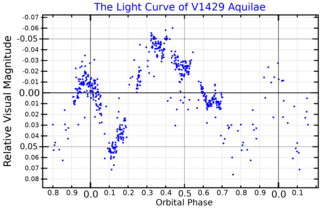
V1429 Aquilae is a candidate luminous blue variable multiple star system located in the constellation of Aquila. It is often referred to by its Mount Wilson Observatory catalog number as MWC 314. It is a hot luminous star with strong emission lines in its spectrum.
R99 is a star in the Large Magellanic Cloud in the constellation Dorado. It is classified as a possible luminous blue variable and is one of the most luminous stars known.

HDE 316285 is a blue supergiant star in the constellation Sagittarius. It is a candidate luminous blue variable and lies about 6,000 light years away in the direction of the galactic centre.
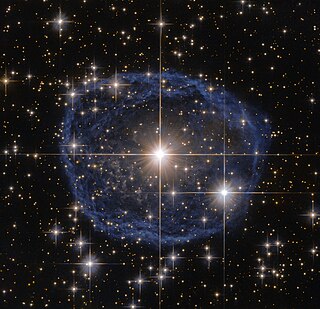
WR 31a, commonly referred to as Hen 3-519, is a Wolf–Rayet (WR) star in the southern constellation of Carina that is surrounded by an expanding Wolf–Rayet nebula. It is not a classical old stripped-envelope WR star, but a young massive star which still has some hydrogen left in its atmosphere.

RW Cygni is a semiregular variable star in the constellation Cygnus, about a degree east of 2nd magnitude γ Cygni. Its apparent magnitude varies between 8.05 and 9.70 and its spectral type between M3 and M4.

R71 is a star in the Large Magellanic Cloud (LMC) in the constellation Mensa. It is classified as a luminous blue variable and is one of the most luminous stars in the LMC. It lies three arc-minutes southwest of the naked-eye star β Mensae.
